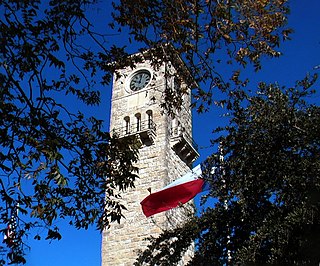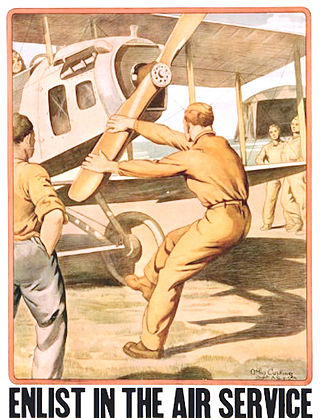
Fort Sam Houston is a U.S. Army post in San Antonio, Texas. Known colloquially as "Fort Sam," it is named for the U.S. Senator from Texas, U.S. Representative from Tennessee, Tennessee and Texas governor, and first president of the Republic of Texas, Sam Houston.

Lackland Air Force Base is a United States Air Force (USAF) base located in Bexar County, Texas, United States. The base is under the jurisdiction of the 802d Mission Support Group, Air Education and Training Command (AETC) and an enclave of the city of San Antonio. It is the only site for USAF and United States Space Force enlisted Basic Military Training (BMT).

Randolph Air Force Base is a United States Air Force base located at Universal City, Texas.

The Texas Air National Guard (TX ANG) is the aerial militia of the State of Texas, United States of America. It is, along with the Texas Army National Guard, an element of the Texas National Guard. No element of the Texas Air National Guard is under United States Air Force command. They are under the jurisdiction of the Governor of Texas through the office of the Texas Adjutant General unless they are federalized by order of the President of the United States. The Texas Air National Guard is headquartered at Camp Mabry, Austin, and its chief of staff is Brigadier General Matthew Barker.

Brooks Air Force Base was a United States Air Force facility located in San Antonio, Texas, 7 miles (11 km) southeast of Downtown San Antonio.

Kelly Field is a Joint-Use facility located in San Antonio, Texas. It was originally named after George E. M. Kelly, the first member of the U.S. military killed in the crash of an airplane he was piloting.

Brooke Army Medical Center (BAMC) is the United States Army's premier medical institution. Located on Fort Sam Houston, BAMC, a 425-bed Academic Medical Center, is the Department of Defense's largest facility and only Level 1 Trauma Center. BAMC is also home to the Center for the Intrepid, an outpatient rehabilitation facility. The center is composed of ten separate organizations, including community medical clinics, centered around the Army's largest in-patient hospital. BAMC is staffed by more than 8,000 Soldiers, Airmen, Sailors, Civilians, and Contractors providing care to wounded Service Members and the San Antonio Community at-large.

Mitchel Air Force Base, also known as Mitchel Field, was a United States Air Force base located on the Hempstead Plains of Long Island, New York, United States. Established in 1918 as Hazelhurst Aviation Field #2, the facility was renamed later that year as Mitchel Field in honor of former New York City Mayor John Purroy Mitchel, who was killed while training for the Air Service in Louisiana.

Rockwell Field is a former United States Army Air Corps (USAAC) military airfield, located 1.1 miles northwest of the city of Coronado, California, on the northern part of the Coronado Peninsula across the bay from San Diego, California.

General John Kenneth Cannon was a World War II Mediterranean combat commander and former chief of United States Air Forces in Europe for whom Cannon Air Force Base, Clovis, New Mexico, is named.

Camp Bullis Military Training Reservation is a U.S. Army training camp comprising 27,990 acres (113.3 km2) in Bexar County, Texas, USA, just northwest of San Antonio. Camp Bullis provides base operations support and training support to Joint Base San Antonio. The camp is named for Brigadier General John L. Bullis.

Ellington Field Joint Reserve Base is a joint installation shared by various active component and reserve component military units, as well as aircraft flight operations of the National Aeronautics and Space Administration (NASA) under the aegis of the nearby Johnson Space Center. The host wing for the installation is the Texas Air National Guard's 147th Attack Wing. Opened in 1917, Ellington Field was one of thirty-two Air Service training camps established after the United States entry into World War I. It is named for First Lieutenant Eric Ellington, a U.S. Army aviator who was killed in a plane crash in San Diego, California in 1913.
The Edward H. White II Museum of Aerospace Medicine was a museum of the United States Air Force and was located in Hangar 9 at Brooks Air Force Base, San Antonio, Texas. Brooks Air Force Base closed in 2011 under Base Realignment and Closure Commission (BRAC) procedures, and the museum closed at the same time.

The 110th Bomb Squadron is a unit of the Missouri Air National Guard 131st Bomb Wing located at Whiteman Air Force Base, Knob Noster, Missouri. The 110th is equipped with the Northrop Grumman B-2 Spirit.

Randolph Field Historic District is a National Historic Landmark District encompassing the central portion of Randolph Air Force Base, near San Antonio, Texas, US. Randolph Field was innovatively designed using Garden city movement principles, and includes a unique and well-preserved assemblage of Mission Revival and Art Deco architecture. Built between 1929 and 1931, it was the first permanent flight training facility of the United States military establishment, then the United States Army Air Corps and later the United States Air Force. It was listed on the National Register of Historic Places in 1996, and was declared a National Historic Landmark in 2001.

Joint Base San Antonio (JBSA) is a United States military facility located in San Antonio, Texas, US. The facility is under the jurisdiction of the United States Air Force 502d Air Base Wing, Air Education and Training Command (AETC). The wing's three Mission Support Groups perform the installation support mission at the three bases that form JBSA.

Henry Post Army Airfield is a military use airport located at Fort Sill in Comanche County, Oklahoma, United States. This military airport is owned by United States Army. Established as Post Field in 1917, it was one of thirty-two Air Service training camps established after the United States entry into World War I in April 1917.

With the purchase of its first airplane, built and successfully flown by Orville and Wilbur Wright, in 1909 the United States Army began the training of flight personnel. This article describes the training provided in those early years, though World War I, and the immediate years after the war until the establishment of the United States Army Air Corps Flight Training Center in San Antonio, Texas during 1926.

The Administration Building at Randolph Air Force Base is headquarters for the 12th Flying Training Wing and located at Universal City, northeast of San Antonio, county of Bexar, in the U.S. state of Texas. The building is referred to as the Taj Mahal, or simply the Taj. It is Building 100 on the base, and was erected in 1931 at a cost of $252,027.50. It was added to the National Register of Historic Places in 1987.
Brooks is a 1,308-acre (529 ha) mixed-use community in the southeast portion of the city of San Antonio, Texas, United States. Brooks was created in 2001 by the United States Congress, the State of Texas and the City of San Antonio to redevelop the former Brooks Air Force Base. Brooks is intended to be a catalyst for economic development, a dynamic mixed-use community and a model for responsible urban planning and development.




















